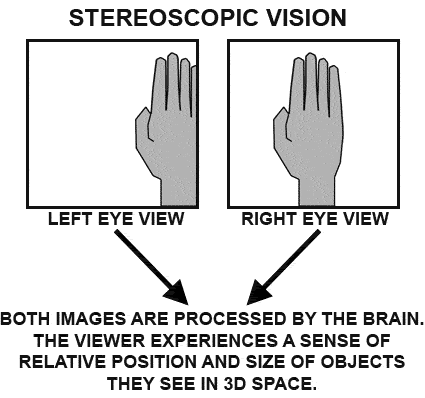Build Your Own: Wall-Sized 3D Gaming, Just Like Theaters Do It
Stereoscopic 3D Display Basics
Since 3D displays are by no means a common household item, most folks are likely to be somewhat uninformed when it comes to how a 3D display actually works. This calls for a short primer. Please keep in mind that we'll focus on the core points for the sake of simplicity.
A human being's ability to perceive the third dimension goes hand-in-hand with our binocular vision. Put simply, we can see in 3D because we have two eyes. Each of our eyes sees the world from a slightly different perspective and our brain combines these perspectives to give us a sense of how close or far an object is. Because there are two separate perspectives, this is commonly referred to as stereoscopic vision.
An easy way to demonstrate stereoscopic vision is with a quick exercise (best performed when you're not looking in the direction of a PC monitor). Close your left eye and put your right hand about four inches in front of your right eye. Wiggle your hand a little. Now, open both eyes and do the same thing with one hand in front of your right eye--you will experience a big difference in your sense of depth and the position of your hand in 3D space. When both of your eyes are providing an alternate perspective, your brain is able to put together that rich sense of relative placement and provide an accurate indication of how far your hand actually is from your face. If you stop moving your hand and close each eye alternatively, you will notice that each eye provides a different view of where your hand sits in your field of vision.
The key to a 3D display, then, is to provide each eye with an alternate view of the same scene. As you can imagine, in the theater or on television this is a bit of a challenge since there is only one screen to look at. How does a 3D display provide a separate image for each eye?
Surprisingly, there are a number of ways to achieve this goal, one of which involves the use of old-school anaglyph red-and-blue colored glasses. But when it comes to widespread and modern applications, there are two stereoscopic 3D systems that rule, or are about to rule, the world: alternate-frame sequencing and dual-projector polarization.
Get Tom's Hardware's best news and in-depth reviews, straight to your inbox.
Current page: Stereoscopic 3D Display Basics
Prev Page Welcome To The Future Next Page Alternate-Frame SequencingDon Woligroski was a former senior hardware editor for Tom's Hardware. He has covered a wide range of PC hardware topics, including CPUs, GPUs, system building, and emerging technologies.
-
Don't gives too big an image to try and see it 3d. A monitor can't handle: 800px \00d7 248px!!!! That's just crazy big!!!Reply
-
Icehearted As for poor folk like me, we'll just settle for those still images where we cross our eyes, and cry because $2,565 is far away from "comfortable".Reply -
tigerwraith 2.6k now but you know things like this keep getting cheaper and cheaper. Maybe by this time next year, the 1080p 2600 lumens will drop to 500, and the drivers will better support dual projector setups.Reply -
gti88 Great article! Thanx a lot.Reply
But as I can see, 3D stereo is not there yet.
Almost no movies are available at 3DS, and game developers don't focus on stereo optimisation. Thus, we have some glitches and inconveniences. -
pojih ahh, something else to cost an arm and a leg...Reply
not saying that many people here don't want the fastest and most expensive....
but it was clearly shown that many people looking at this site want something that performs for what it costs, as seen by the fermi release and the comments ..... -
skora Whats the next price bracket up for a projector with higher res?Reply
I like the idea of dual projectors better than the alt-image standard, but they didn't ask me.
Here's a wild thought, soon, everyone will have their own glasses that not only do the shutter for 3D, but will also be able to be personal monitors. Connect to any computer/phone/TV with your glasses. Displays might even become unnecessary. That will be the next wireless mainstream device. The iShades. Phone, mobile pc and display, earbud is right there. Have pants that have built in keyboard. We'll all just be sitting there with our shades on and never see the person next to us as we get lost in the cloud. And it all starts with 3D glasses. :P -
djab IceheartedAs for poor folk like me, we'll just settle for those still images where we cross our eyes, and cry because $2,565 is far away from "comfortable".Reply
No, you can at least use red/cyan paper glasses with iz3d drivers and a normal display.
That is not that bad!
